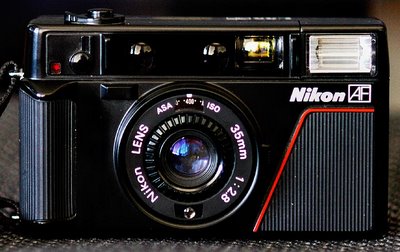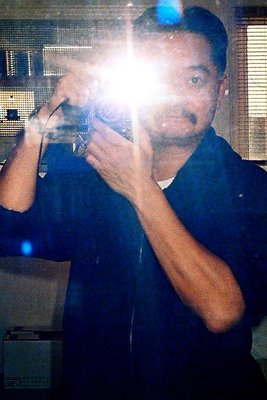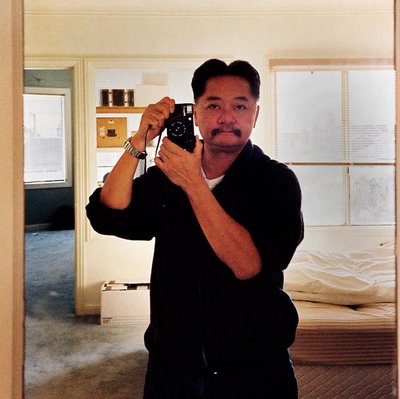Pikaichi!!! Another Classic Compact
Pikaichi means "Top Notch" in Japanese. Nikon had so much confidence in it, that they named the L35AF, Pikaichi, in the Japanese market version of its very first compact, AF, P&S. You may remember that I mentioned a dead Nikon L35AF that I got as part of a barter deal that included that incredible Olympus XA2. I was really hoping that the Nikon would be functional because I was very curious to see how it performed.
 The L35 was introduced in 1983, and it became a huge success. The external design of the L35 was done by the famed Italian industrial designer, Giugiaro. Giorgetto Giugiaro was hired by Nikon in the early 80's to design their flagship professional slr, the Nikon F3. Subsequently, Giurgiaro had a hand in designing every significant Nikon slr (F3, F4, F5, F6, D1, D2, D200, etc.). Giugiaro was also named the car designer of the century in 1999. You'll recognize the names of some of the supercars that he designed: BMW M1, Lotus Esprit, De Tomaso Mangusta, De Lorean DMC-12, Ferrari 250GT, Maserati Bora, to name just a few. You can see the signature Nikon red stripe on the front of my L35.
The L35 was introduced in 1983, and it became a huge success. The external design of the L35 was done by the famed Italian industrial designer, Giugiaro. Giorgetto Giugiaro was hired by Nikon in the early 80's to design their flagship professional slr, the Nikon F3. Subsequently, Giurgiaro had a hand in designing every significant Nikon slr (F3, F4, F5, F6, D1, D2, D200, etc.). Giugiaro was also named the car designer of the century in 1999. You'll recognize the names of some of the supercars that he designed: BMW M1, Lotus Esprit, De Tomaso Mangusta, De Lorean DMC-12, Ferrari 250GT, Maserati Bora, to name just a few. You can see the signature Nikon red stripe on the front of my L35.
After being tantalized by holding and examining the broken L35, I decided that I needed to find a working one so that I can judge for myself why this camera is so highly regarded. This is reportedly the ONLY Nikon compact that is of any interest to collectors. Well, I'm happy to report that I was lucky enough to find one on Ebay, and that I won the auction for the ridiculously low price of $1.75 (!!!). Yes, you read that right, $1.75! Not only that, the seller was local, so I went to pick it up directly from the seller and saved the trouble of packing and the shipping cost.
The L35 is not a shirt pocket camera, it might fit in a large coat pocket. Instead, it reminds me a lot of a slightly undersized rangefinder of classic proportions. Nikon chose a rugged, but slightly weighty design of plastic body over a metal chassis. This design is unheard of in a P&S camera, and Nikon discontinued this practice in subsequent versions. That broken L35 that I got must have been used and abused pretty badly. The L35 looks, feels, and handles like a "real" camera. Interestingly, the L35's appearance reminds me a lot of the Konica Hexar AF, which is something of a cult classic. The Hexar also had a fixed, 35mm (f2.0) lens (I wish I never sold mine).
Following are some significant features of the L35:
- Very accurate, IR active autofocus system
- Reverse Galilean Viewfinder with floating framelines
- Mechanical AF indicator in viewfinder for focus verification (no other P&S had this)
- Programmed auto exposure with +2 stop exposure compensation lever for backlit situations
- Fixed focal length, 5 element/4 groups, high quality, coated, 35mm f2.8 lens
- Motorized film advance
- Motorized film rewind that leaves the leader out
- Built-in, automatic, pop-up flash
- Outdoor fill flash capability
- Self timer
- Threaded lens for 46mm filters
- Manual ASA setting for ASA 64-1000 (late models like mine have this expanded range)
- Uses 2 AA alkaline batteries (commonly available)
So did I finally get a working L35AF? The answer is a resounding, YES! I will post a series from my first roll through his classic camera a little later. For now, here are my first two shots. Film used was Kodak SG400 color print film.
(Self Portrait) Frame #1, oops! It's not a good idea to use the flash directly in a mirror but it does make an interesting picture, no?

(Self Portrait) Frame #2, okay, this is more like it :). Please excuse the messy background :).

I hope you enjoyed this little classic camera review. My recommendation for the Nikon L35AF is the same as my recommendation for the Olympus XA2, if you see one at a yard sale or Craigslist, by all means, buy it and use it.
Merry Christmas, and Happy Holidays!
--Warren
 The L35 was introduced in 1983, and it became a huge success. The external design of the L35 was done by the famed Italian industrial designer, Giugiaro. Giorgetto Giugiaro was hired by Nikon in the early 80's to design their flagship professional slr, the Nikon F3. Subsequently, Giurgiaro had a hand in designing every significant Nikon slr (F3, F4, F5, F6, D1, D2, D200, etc.). Giugiaro was also named the car designer of the century in 1999. You'll recognize the names of some of the supercars that he designed: BMW M1, Lotus Esprit, De Tomaso Mangusta, De Lorean DMC-12, Ferrari 250GT, Maserati Bora, to name just a few. You can see the signature Nikon red stripe on the front of my L35.
The L35 was introduced in 1983, and it became a huge success. The external design of the L35 was done by the famed Italian industrial designer, Giugiaro. Giorgetto Giugiaro was hired by Nikon in the early 80's to design their flagship professional slr, the Nikon F3. Subsequently, Giurgiaro had a hand in designing every significant Nikon slr (F3, F4, F5, F6, D1, D2, D200, etc.). Giugiaro was also named the car designer of the century in 1999. You'll recognize the names of some of the supercars that he designed: BMW M1, Lotus Esprit, De Tomaso Mangusta, De Lorean DMC-12, Ferrari 250GT, Maserati Bora, to name just a few. You can see the signature Nikon red stripe on the front of my L35.After being tantalized by holding and examining the broken L35, I decided that I needed to find a working one so that I can judge for myself why this camera is so highly regarded. This is reportedly the ONLY Nikon compact that is of any interest to collectors. Well, I'm happy to report that I was lucky enough to find one on Ebay, and that I won the auction for the ridiculously low price of $1.75 (!!!). Yes, you read that right, $1.75! Not only that, the seller was local, so I went to pick it up directly from the seller and saved the trouble of packing and the shipping cost.
The L35 is not a shirt pocket camera, it might fit in a large coat pocket. Instead, it reminds me a lot of a slightly undersized rangefinder of classic proportions. Nikon chose a rugged, but slightly weighty design of plastic body over a metal chassis. This design is unheard of in a P&S camera, and Nikon discontinued this practice in subsequent versions. That broken L35 that I got must have been used and abused pretty badly. The L35 looks, feels, and handles like a "real" camera. Interestingly, the L35's appearance reminds me a lot of the Konica Hexar AF, which is something of a cult classic. The Hexar also had a fixed, 35mm (f2.0) lens (I wish I never sold mine).
Following are some significant features of the L35:
- Very accurate, IR active autofocus system
- Reverse Galilean Viewfinder with floating framelines
- Mechanical AF indicator in viewfinder for focus verification (no other P&S had this)
- Programmed auto exposure with +2 stop exposure compensation lever for backlit situations
- Fixed focal length, 5 element/4 groups, high quality, coated, 35mm f2.8 lens
- Motorized film advance
- Motorized film rewind that leaves the leader out
- Built-in, automatic, pop-up flash
- Outdoor fill flash capability
- Self timer
- Threaded lens for 46mm filters
- Manual ASA setting for ASA 64-1000 (late models like mine have this expanded range)
- Uses 2 AA alkaline batteries (commonly available)
So did I finally get a working L35AF? The answer is a resounding, YES! I will post a series from my first roll through his classic camera a little later. For now, here are my first two shots. Film used was Kodak SG400 color print film.
(Self Portrait) Frame #1, oops! It's not a good idea to use the flash directly in a mirror but it does make an interesting picture, no?

(Self Portrait) Frame #2, okay, this is more like it :). Please excuse the messy background :).

I hope you enjoyed this little classic camera review. My recommendation for the Nikon L35AF is the same as my recommendation for the Olympus XA2, if you see one at a yard sale or Craigslist, by all means, buy it and use it.
Merry Christmas, and Happy Holidays!
--Warren
Labels: L35AF

6 Comments:
Warren, I really enjoy your camera posts - they are as good or better than the best I've seen in magazines (like "Keppler on SLR" and Jason Schneider's former "Camera Collector" column.)
I especially like that you're getting these good-looking, good-shooting cameras for peanuts.
Looking forward to the new little Nikon's photos.
Warren, I also really enjoy these reviews, only they give me major gas and I'm doing all I can to not go find and get one!!
I think this lens must be very good, a quick google search shows many great reviews of the lens used on this p&s, I wonder if it has roots to the nikkor-w of which possibly the hexar af's 35mm/f2 lens was dervied, I also regret selling my hexar af. I've read that the interesting thing about the hexar af lens was that it was not corrected for wide open f2 use, but therefore contributed to it's unique signature wide open.
I wonder about the auto programming of these p&s cameras, some were rather primitive staying stopped down until a low enough EI/EV was reached where the shutter was real slow before the lens would open up wide.
I personally am not a big fan of the nikon designer, I think he designed the F3's HP prism exterior, and while the HP is definitely nice for eyeglass users and all, to me it's much less elegant than the simple DE prism, from the exterior.
When I get home, I'll see if I still have my old Nikon point and shoot. It's kind of like the one you bought. If so, I'll bring it out so you can check it out this weekend. I almost forgot all about it.
Eric
Hi Guys,
Thanks for the kind words. I'm glad you're enjoying my obsessional camera ramblings :).
Ted, just my opinion, but I think the DE-3 High Eyepoint finder is more an example of form following function where the the design had to give way to the physical constraints of providing the high eye relief. Since the DE-2 (regular prism) was also offered on the Nikon F3, Giugiaro must have had a hand in designing that too. I think Giugiaro's major contribution to the Nikon line is the consistently recognizable signature features, like the discretely placed red trim pieces, and the consistently beautiful and functional ergonomic design (the Nikon F4 is a favorite example of mine).
I think the W-Nikkor 35mm f1.8 and the genetically similar Hexar 35mm f2.0 are more complicated designs (7 elements/6 groups), and are superior to the L35's lens in both resolution and distortion control.
--Warren
Note: I just discovered some bad html on my post that prevented you from seeing the full sized picture of the L35. I fixed it, so now you can click on the L35 picture to see a larger image of it.
--WT
I actually like the flash version (pic#1) so much that I'm using it (slightly edited) as my avatar on Rangefinderforum.com.
--WT
Post a Comment